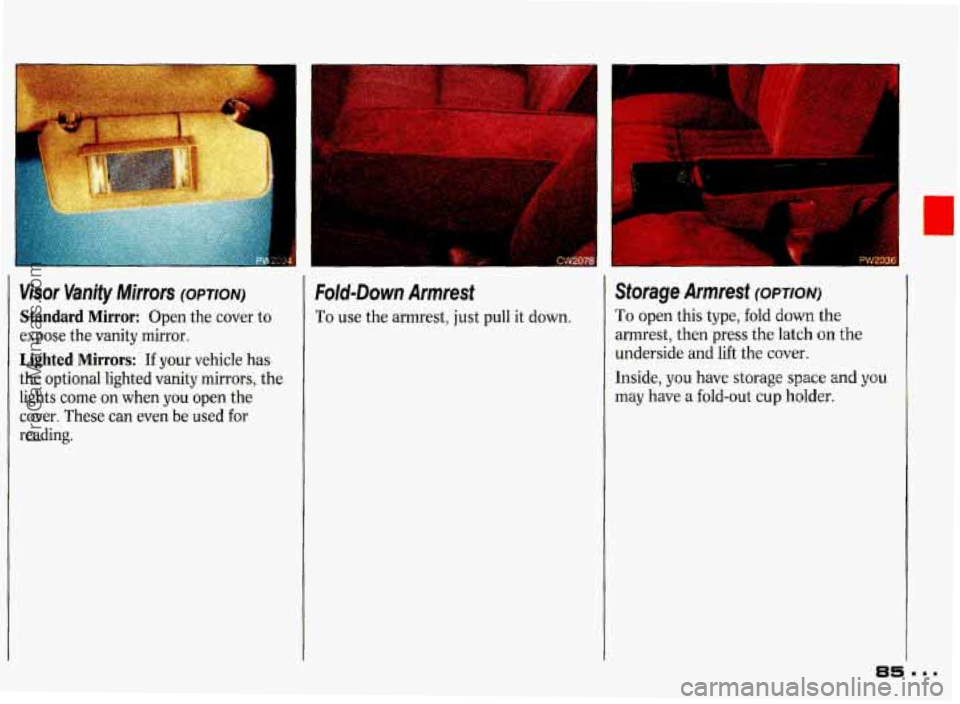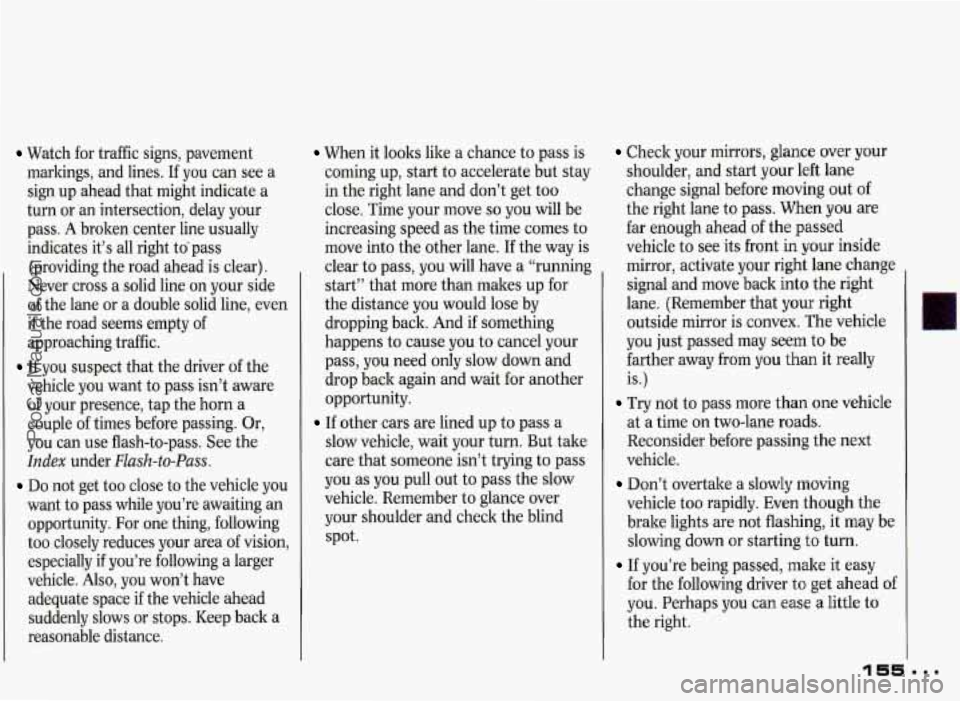1993 PONTIAC GRAND-PRIX mirror
[x] Cancel search: mirrorPage 44 of 338

Here you can learn about the
many standard and optional
features on your Pontiac. and information on starting. shifting and
braking
. Also explained are the
instrument panel and the warning
systems that tetl you if everything is
working properly-and what to
do if
you have a problem .
Features & Controls
Keys ........................................................................\
........................................... 44
Locks ........................................................................\
......................................... 45
Remote Lock Control ........................................................................\
................ 46
Glove Box ........................................................................\
................................... 50
Ignition ........................................................................\
....................................... 52
Starting Your Engine ........................................................................\
................. 54
Engine Block Heater ........................................................................\
.................. 56
Shifting the Transaxle ........................................................................\
................ 57
Second-Gear Start ........................................................................\
..................... 61
Parking Brake ........................................................................\
............................. 64
Shifting into Park ........................................................................\
....................... 65
Windows ........................................................................\
..................................... 70
Turn Signal/Headlight Beam Lever .................................................................. 70
Cruise Control ........................................................................\
............................ 72
Windshield Wipers ........................................................................\
..................... 76
Windshield Washer ........................................................................\
.................... 77
Headlights ........................................................................\
.................................. 78
Interior Lights ........................................................................\
............................ 81
Mirrors ........................................................................\
........................................ 83
Storage Compartments ........................................................................\
.............. 85
Ashtrays and Lighter ........................................................................\
................. 87
Sunroof ........................................................................\
....................................... 90
Instrument Panel ........................................................................\
....................... 92
Warning Lights, Gages and Indicators .............................................................. 95
Driver Information Center ........................................................................\
...... 105
Head-Up Display ........................................................................\
..................... 110
ProCarManuals.com
Page 82 of 338

Reading Lights
Reading lights have a switch. You can
also
turn them on with the brightness
intensity control.
To avoid draining your vehicle's battery,
be sure
to turn off all front and rear
reading lights when you leave your
vehicle.
W216l
Rearview Mirror Reading lights
(OPTION)
These lights are part of the rearview
mirror. They go on when you open the
doors. When the doors are
closed, turn
them
on and off with the switch.
W203E
Dome Reading Lights (OPTION)
These lights are part of your dome light.
Press the switch nearest the light you
want on. Press the switch again to turn
the light
off.
81
ProCarManuals.com
Page 84 of 338

Illuminated Entry (OPTION)
If you have illuminated entry, your
interior lights will stay on for about
12
seconds after the door is closed.
The lights will go out when the ignition
key is turned to the
Run position.
Inside Manual DaylNight
Rearview Mirror
To reduce glare from lights behind you,
pull the lever toward you to the night
position.
Convex Outside Mirror
Your right side mirror is convex. A
convex mirror’s surface is curved so yo^
can see more from the driver’s seat.
A
If you aren’t used to a convex
mirror, you can hit another
vehicle.
A convex mirror can make
things (like other vehicles) look
farther away than they really are.
If
you cut too sharply into the right
lane, you could hit
a vehicle on
your right. Check your inside
mirror or glance over
your shoulder
before changing lanes.
a:
1
I
...
ProCarManuals.com
Page 85 of 338

Features & Controls
Outside Mirrors
To adjust your left outside mirror, move
the knob.
To adjust your right outside mirror, sit
in the driver's seat and have a passenger
adjust the mirror for you.
Adjust each mirror
so you can just see
the side of your vehicle when you are
sitting in a comfortable driving position.
..
Electric Mirror Control (OPTION)
A selector switch on the driver's door
armrest controls both outside rearview
mirrors.
Move the switch to L to select
the driver's side rearview mirror, or
to
R to select the passenger side rearview
mirror. Then press the control pad to
adjust each mirror
so that you just see
the side of your vehicle when you are
sitting in
a comfortable driving position.
To lock the controls, leave the selector
switch
in the middle position.
Sun Visors
To block out glare, you can swing down
the visors.
You can also remove them
from the center mount and swing them
to the side.
Your
sun visors may have pockets for
storing light items, such as maps.
ProCarManuals.com
Page 86 of 338

r
1
Visor Vanity Mirrors (OPTION)
Standard Mirror: Open the cover to
expose the vanity mirror.
Lighted Mirrors: If your vehicle has
the optional lighted vanity mirrors, the
lights come on when
you open the
cover. These can even be used for
reading.
Fold-Down Armrest
To use the armrest, just pull it down.
c
Storage Armrest (OPTION)
To open this type, fold down the
armrest, then press the latch
on the
underside and lift the cover.
Inside,
you have storage space and you
may have a fold-out cup holder.
ProCarManuals.com
Page 156 of 338

Watch for traffic signs, pavement markings, and lines.
If you can see a
sign up ahead that might indicate a
turn or an intersection, delay your
pass. A broken center line usually
indicates it’s all right tdpass
(providing the road ahead is clear).
Never cross a solid line
on your side
of the lane or a double solid line, even
if the road seems empty of
approaching traffic.
If you suspect that the driver of the
vehicle you want to pass isn’t aware
of your presence, tap the horn a
couple of times before passing. Or,
you can use flash-to-pass. See the
Index under Flash-to-Pass.
Do not get too close to the vehicle you
want to pass while you’re awaiting an
opportunity. For one thing, following
too closely reduces your area of vision,
especially
if you’re following a larger
vehicle. Also, you won’t have adequate space if the vehicle ahead
suddenly slows or stops. Keep back a
reasonable distance.
When it looks like a chance to pass is
coming up, start to accelerate but stay
in the right lane and don’t get too
close. Time your move
so you will be
increasing speed as the time comes to
move into the other lane.
If the way is
clear to pass, you will have a “running
start” that more than makes up for
the distance
you would lose by
dropping back. And if something
happens to cause you to cancel your
pass, you need only slow down and
drop back again and wait for another
opportunity.
slow vehicle, wait your turn. But take
care that someone isn’t trying to pass
you as you pull out to pass the slow
vehicle. Remember to glance over
your shoulder and check the blind
spot.
If other cars are lined up to pass a
Check your mirrors, glance over your
shoulder, and start your left lane
change signal before moving out of
the right lane to pass. When you are
far enough ahead of the passed
vehicle to see its front in your inside
mirror, activate your right lane change
signal and move back into the right
lane. (Remember that your right
outside mirror is convex. The vehicle
you just passed may seem to be
farther away from you than
it really
is
.)
Try not to pass more than one vehicle
at a time on two-lane roads.
Reconsider before passing the next
vehicle.
vehicle too rapidly. Even though the
brake lights are not flashing, it may be
slowing down or starting
to turn.
If you’re being passed, make it easy
for the following driver
to get ahead of
you. Perhaps you can ease a little to
the right.
Don’t overtake a slowly moving
ProCarManuals.com
Page 158 of 338

recognize warning clues-such as
enough water, ice or packed snow
on
the road to make a “mirrored
surface”-and slow down when you
have any doubt.
If you have the anti-lock braking
system, remember: It helps avoid only
the braking skid.
If you do not have
anti-lock, then in a braking skid (where
the wheels are no longer rolling),
release enough pressure on the brakes
to get the wheels rolling again. This
restores steering control. Push the
brake pedal down steadily when you
have to stop suddenly. As long as the
wheels are rolling, you will have steering control. Steer the way you
want to go.
Driving at Night
Night driving is more dangerous than
day driving. One reason is that some
drivers are likely to be impaired-
by alcohol or drugs, with night vision
problems, or by fatigue.
Here are some tips on night driving.
Drive defensively. Remember, this is
the most dangerous time.
Don’t drink and drive. (See the Index
under Drunken Driving for more on
this problem.)
Adjust your inside rearview mirror to
reduce the glare hom headlights
behind you.
II
Since you can’t see as well, you may
need to slow down and keep more
space between you and other vehicles.
It’s hard to tell how fast the vehicle
ahead is going just by looking at its
taillights.
speed roads. Your headlights
can light
up only
so much road ahead.
Slow down, especially on higher
In remote areas, watch for animals.
If you’re tired, pull off the road in a
safe place and rest.
I
ProCarManuals.com
Page 159 of 338

Your Driving and the Road
Night Vision
No one can see as well at night as in the
daytime. But as we get older these
differences increase.
A 50-year-old
driver may require at least twice as
much light to see the same thing at
night as a 20-year-old.
What you do in the daytime can also
affect your night vision. For example, if
you spend the day in bright sunshine
you are wise to wear sunglasses. Your
eyes will have less trouble adjusting to
night.
But if you’re driving, don’t wear
sunglasses at night. They may cut down
on glare from headlights, but they also
make a lot of things invisible that
should remain visible-such as parked
cars, obstacles, pedestrians, or even
trains blocking railway crossings. You
may want to put on your sunglasses
after you have pulled into a brightly-
lighted service or refreshment area.
158
-
Eyes shielded from that glare may
adjust more quickly to darkness back
on the road. But be sure to remove your
sunglasses before you leave the service
area.
You can be temporarily blinded by
approaching lights. It can tale a second
or two, or even several seconds, for
your eyes to readjust to the dark. When
you are faced with severe glare (as
from
a driver who doesn’t lower the high
beams, or a vehicle with misaimed
headlights), slow down a little. Avoid
staring directly into the approaching
lights. If there is
a line of opposing
traffic, make occasional glances over the
line of headlights to make certain that
one of the vehicles isn’t starting to
move into your lane. Once you are past
the bright lights, give your eyes time to
readjust before resuming speed.
High Beams
If the vehicle approaching you has its
high beams on, signal by flicking yours
to high and then back to low beam. This
is the usual signal to lower the
headlight beams. If the other driver still
doesn’t lower the beams, resist the
temptation to put your high beams on.
This only makes two half-blinded
drivers.
On a freeway, use your high beams only
in remote areas where you won’t impair
approaching drivers. In some places,
like cities, using high beams is illegal.
When you follow another vehicle on a
freeway or highway, use low beams.
True, most vehicles now have day-night
mirrors that enable the driver to reduce
glare. But outside mirrors are not of this
type and high beams from behind can
bother the driver ahead.
ProCarManuals.com